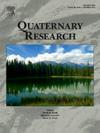Late glacial to Holocene fluvial dynamics in the Upper Rhine alluvial plain, France
IF 1.7
3区 地球科学
Q3 GEOGRAPHY, PHYSICAL
引用次数: 0
Abstract
High-resolution sedimentological and geochronological investigations of paleochannel systems in the Ried Central d'Alsace (northeastern France) allow for the reconstruction of the late glacial and Holocene fluvial evolution of this section of the Upper Rhine alluvial plain. During the Oldest Dryas, the landscape featured a dominant braided Rhine system and, to a lesser extent, a braided Fecht system. The shift to the Bølling-Allerød saw a narrowing of the Rhine's active channel belt, the development of a complex channel pattern, and the genesis of the Ill River. The river channel patterns remained unchanged during the Younger Dryas. In the Early Holocene, the Rhine's active belt narrowed further, and the Rhine and Ill Rivers developed braided-anastomosing and anastomosing channel patterns, respectively. Throughout the Holocene, both rivers maintained their channel patterns while migrating east and west across the alluvial plain, respectively. In the late glacial, fluvial dynamics in this section of the Upper Rhine plain were primarily influenced by climate-related environmental and hydrogeomorphological changes. Conversely, during the Holocene, the evolution of the fluvial hydrosystems was driven by a complex interaction of climatic and non-climatic factors, including human activity at the catchment scale, alluvial plain architecture, and local neotectonics.法国上莱茵冲积平原晚冰期至全新世的河川动力学
通过对阿尔萨斯中部山区(法国东北部)古河道系统的高分辨率沉积学和地质年代学研究,可以重建莱茵河上游冲积平原这一地段的晚冰期和全新世河道演变过程。在最古老的旱期,该地貌以莱茵河辫状河系为主,其次是费希特河辫状河系。在向博林-阿勒罗德转移的过程中,莱茵河的活动河道带变窄,河道形态变得复杂,并形成了伊利河。河道格局在小干河时期保持不变。在全新世早期,莱茵河的活动河道带进一步变窄,莱茵河和伊河分别形成了辫状吻合和吻合河道模式。在整个全新世,两条河流在冲积平原上分别向东和向西迁移的同时,保持着各自的河道形态。在冰川晚期,上莱茵河平原该河段的河流动力学主要受到与气候相关的环境和水文地质变化的影响。相反,在全新世期间,河流水系的演变则受到气候和非气候因素的复杂影响,包括流域范围内的人类活动、冲积平原结构和当地新构造运动。
本文章由计算机程序翻译,如有差异,请以英文原文为准。
求助全文
约1分钟内获得全文
求助全文
来源期刊

Quaternary Research
地学-地球科学综合
CiteScore
4.70
自引率
8.70%
发文量
57
审稿时长
3 months
期刊介绍:
Quaternary Research is an international journal devoted to the advancement of the interdisciplinary understanding of the Quaternary Period. We aim to publish articles of broad interest with relevance to more than one discipline, and that constitute a significant new contribution to Quaternary science. The journal’s scope is global, building on its nearly 50-year history in advancing the understanding of earth and human history through interdisciplinary study of the last 2.6 million years.
 求助内容:
求助内容: 应助结果提醒方式:
应助结果提醒方式:


